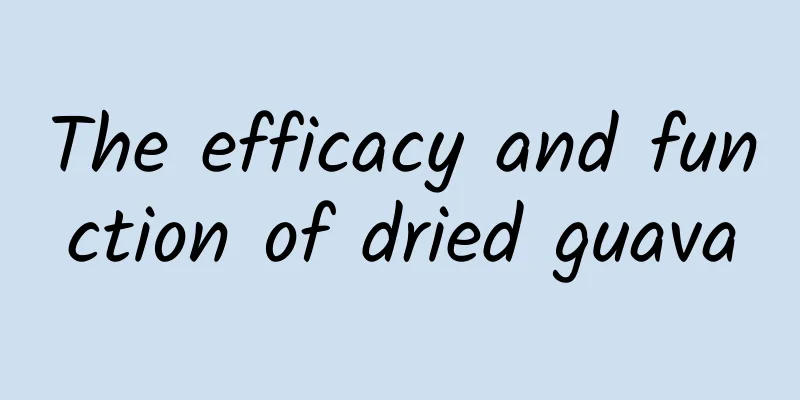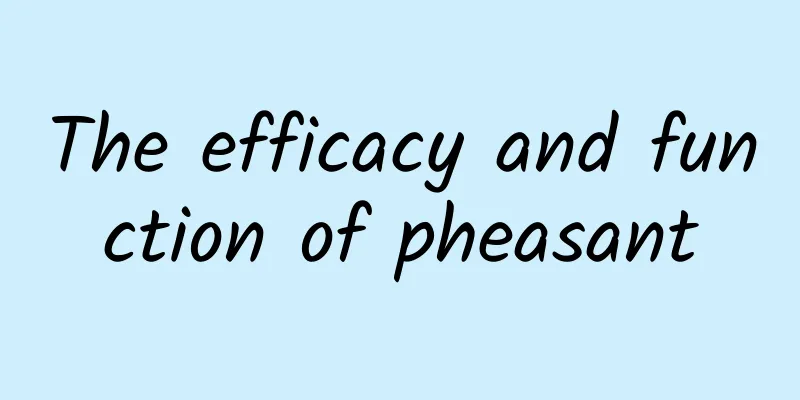The efficacy and function of dried guava

|
Dried guava is a traditional Chinese medicine. It has high medicinal value and has a good health-care effect on some diseases. In our lives, many medicines use dried guava as the main ingredient, but there are still many taboos to pay attention to when taking dried guava. [Source] It is the immature dried young fruit of the guava plant of the Myrtaceae family. Harvest in summer and autumn and sun-dried. Produced in Guangdong, Guangxi and other places. [Original form] Guava (Illustrated Catalogue of the Names and Realities of Guava), also known as: autumn fruit (Notes on Nanyue), chicken-arrow fruit (Illustrated Catalogue of the Names and Realities of Plants), Linba, Bazai, Yeba, Mubazi, trumpet guava, foreign devil, hundred-son tree, Luoba, flower guava, rice peach, foreign peach tree, suburban peach, and foreign guava. [Habitat distribution] Distributed in Guangdong, Guangxi, Sichuan, Yunnan, Fujian and other places. [Properties] The dry immature young fruit is spherical, oval or pear-shaped, with a horizontal diameter of 2 to 3 cm; it is green when fresh and dark brown when dry; the surface is slightly rough and hard, with persistent calyx and residual style on the top. The flesh is hard, light brown, 5-chambered, and contains many seeds densely embedded inside; the seeds are gray-brown, as big as mung beans, and irregularly oblate or triangular in shape. The taste is slightly sour and astringent, with a slight fragrance. The full and firm ones are preferred. [Chemical composition] The fruit contains β-sitosterol, quercetin, guajava glycoside, gallic acid, gallic acid, colorless cyanidin, vitamin C (330 mg), and rhamnose, xylose, ribose, arabinose, fructose, glucose, galactose, sucrose, valine, alanine, threonine, aspartic acid, glutamic acid, and cysteine. It also contains polysaccharides such as scutellaria baicalensis glycosides and arabinan. 【Properties and flavors】 "Guangdong Chinese Medicine" Ⅱ: "sour, astringent, warm." 【Functions and indications】 ① "Guangxi Medicinal Plant List": "Antidiarrhea." [Usage and Dosage] For oral use: decoct in water, 2 to 3 qian. [Additional prescription] To detoxify croton: 3 grams each of dried angelica sinensis, stir-fried white atractylodes, and pomegranate peel. Add one and a half bowls of water, boil until one bowl remains, and drink it. (Main poisonous plants in the South) 【Excerpt】 《*Dictionary》 【Source】 From "Guangxi Chinese Materia Medica" The above is an introduction to dried guava. Through this introduction we can understand that dried guava has high medicinal value and can effectively relieve many diseases, but remember not to take it indiscriminately. |
<<: The efficacy and function of stinking cabbage leaves
>>: The efficacy and function of the poison grass
Recommend
The efficacy and function of Dasin
Although Western medicine and Western drugs are m...
See the big picture from the small details and make science within reach: Science Popularization China Lite is here!
On January 16, 2024, at the "2023 Science Po...
The efficacy and function of Vitex rotundifolia
In our lives, Vitex rotundifolia has attracted ou...
Can ordinary people diagnose depression, mania, and bipolar disorder on their own?
Review expert: Chen Mingxin, national second-leve...
The efficacy and function of Shuga Senecio
Shuga Senecio is a very common Chinese medicine. ...
Besides painkillers, what other methods can we use to relieve pain?
Produced by: Science Popularization China Author:...
Boston Consulting Group: 2024 Black Friday Consumer Research Report
Boston Consulting Group released its "Black ...
Is a "space funeral" actually possible?
It is said that when a loved one dies, they will ...
Horror movie comes true: flood, more than 70 crocodiles escape...
On September 11, a video circulated online said t...
The starting price was 25,000 and it was sold out in an instant, causing the server to crash! Will Apple's head-mounted display be the next iPhone?
At the Apple Worldwide Developers Conference on J...
What are the medicinal values of willow twigs?
Willow trees are now a very common tree species i...
27-year-old female host died suddenly after infusion! The "silent killer" is this... commonly used in respiratory department!
Expert of this article: Liu Zhijun, Pharmacy Depa...
Prozac is still unsolved: Where is the future of new antidepressant drugs?
In 1954, the first compound with antidepressant e...
Are sun protection clothes worth tens of dollars a rip-off or are they really useful? This article teaches you how to choose the right one
Spring is here and it’s time to go out for an out...









